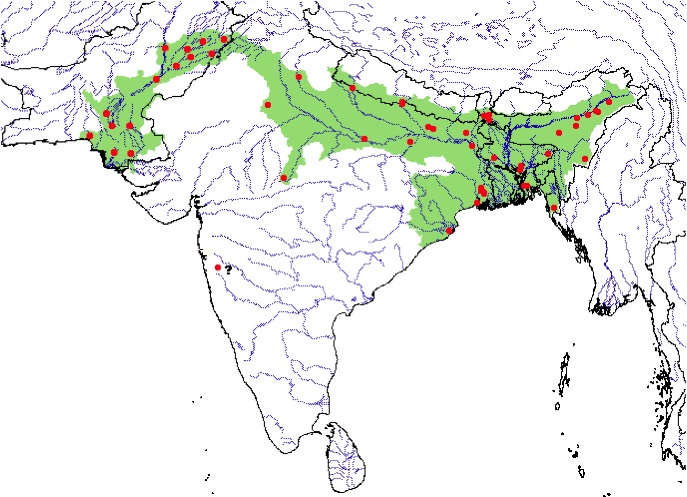Nilssonia hurum, 048
Nilssonia hurum (Gray 1830) –
Indian Peacock Softshell Turtle
Indraneil Das1, Dhruvajyoti Basu2, and Shailendra Singh3
1Institute of Biodiversity and Environmental Conservation, Universiti Malaysia Sarawak,
94300 Kota Samarahan, Sarawak, Malaysia [[email protected]];
2Katerniaghat Foundation, (R)1/737 Vikas Nagar, Lucknow 226 022, Uttar Pradesh, India [[email protected]];
3Centre for Herpetology, Madras Crocodile Bank Trust, Post Bag 4, Mamallapuram 603 104,
Tamil Nadu, India [[email protected]]
Summary. – The Indian peacock softshell turtle, Nilssonia hurum (Family Trionychidae), is a relatively abundant large riverine species that is found in rivers and reservoirs. The species attains a rather large size (carapace length to 60 cm). It is distributed over eastern Pakistan, northern and central India, Bangladesh, and Nepal. The species is primarily nocturnal and omnivorous, juveniles observed feeding on mosquito larvae and fish, while adults consume snails, earthworms, prawns, fish, frogs, carrion, and vegetation. Animals maintained in captivity are known to eat rice and palm sugar sweetmeats. Courtship takes place underwater, and spherical, brittle-shelled, eggs in clutches numbering 20–30 are produced between August to November; hatching takes place between June–July of the following year. The species is heavily exploited for its meat and calipee (the outer cartilaginous rim of the shell) throughout northern and eastern India and Bangladesh. The intensity of exploitation to which it is subject suggests that both some kind of quota or closed season system, as well as protection of nesting areas, are necessary.
Distribution. – Bangladesh, India, Nepal, Pakistan. Distributed across eastern Pakistan, northern, central, and eastern India, southern Nepal, and all of Bangladesh.
Synonymy. – Trionyx occellatus Gray 1830a, Trionyx ocellatus, Gymnopus ocellatus, Trionyx hurum Gray 1830b, Isola hurum, Aspideretes hurum, Aspidonectes hurum, Tyrse hurum, Amyda hurum, Nilssonia hurum, Gymnopus duvaucelii Duméril and Bibron 1835, Trionyx sewaare Gray 1872, Trionyx bellii Gray 1872, Trionyx buchanani Theobald 1874.
Subspecies. – None.
Status. – IUCN 2010 Red List: Vulnerable (A1cd+2d) (assessed 2000); CITES: Appendix I; Indian Wildlife (Protection) Act: Schedule I; Bangladesh Wildlife (Preservation) Act: Schedule III.
Citation:
Das, I., Basu, D., and Singh, S. 2010. Nilssonia hurum (Gray 1830) – Indian peacock softshell turtle. In: Rhodin, A.G.J., Pritchard, P.C.H., van Dijk, P.P., Saumure, R.A., Buhlmann, K.A., Iverson, J.B., and Mittermeier, R.A. (Eds.). Conservation Biology of Freshwater Turtles and Tortoises: A Compilation Project of the IUCN/SSC Tortoise and Freshwater Turtle Specialist Group. Chelonian Research Monographs No. 5, pp. 048.1–048.6, doi:10.3854/crm.5.048.hurum.v1.2010, //iucn-tftsg.org/cbftt/.
(Adobe Acrobat 6.0 or later required)

Adult female Nilssonia hurum from the Brahmaputra River, India.
Photo by Chittaranjan Baruah.
Distribution:

Distribution of Nilssonia hurum in Pakistan, India, and Bangladesh. Red points = museum and literature occurrence records based on Iverson (1992) plus more recent and authors’ data; green shading = projected distribution based on GIS-defined hydrologic unit compartments (HUCs) constructed around verified localities and then adding HUCs that connect known point localities in the same watershed or physiographic region, and similar habitats and elevations as verified HUCs (Buhlmann et al. 2009), and adjusted based on authors’ data. The question mark indicates the isolated questionable locality of Pune, Maharashtra.








